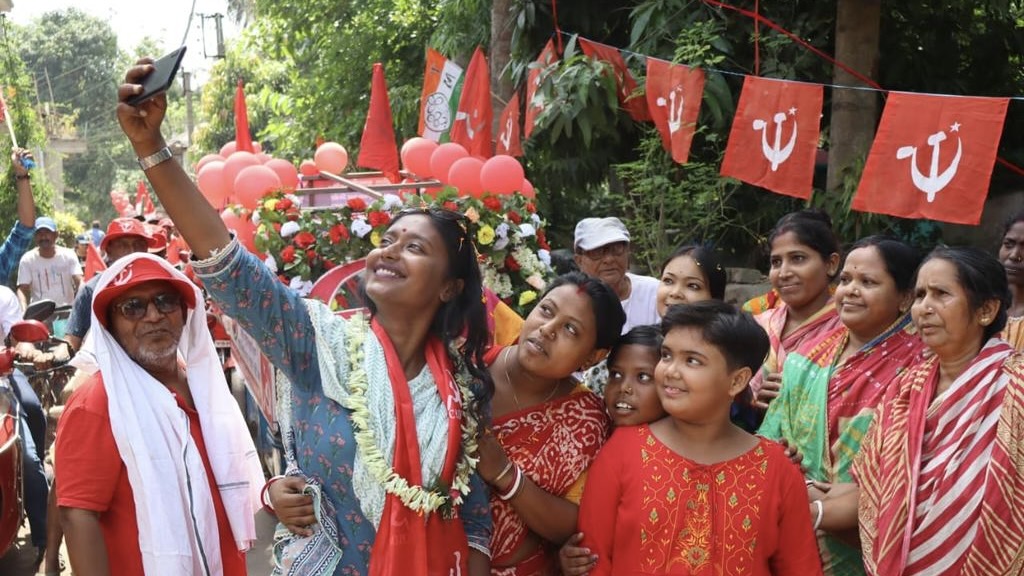Student leaders are waging a difficult but determined battle to revive the electoral prospect of the left in the ongoing national elections in India. These young politicians have taken up the challenge to put the people’s agenda in front in their electoral campaigns and defeat the right-wing parties.
In West Bengal, the fourth most populous state in India, Dipsita Dhar (30), Srijan Bhattacharya (31) and Pratikur Rahman (33) are three representatives of this young brigade which is putting a spirited fight against both the Trinamool Congress (TMC) ruling the state and Bharatiya Janata Party (BJP) governing at the center.
All of these candidates have been or still are leaders of the student movement and members of left-wing student organizations. They represent the changing expectations of India’s youth and appear to strike a chord with the people. They wish to restore the sanity in politics of the state and defeat the politics of religious and sectarian divide which has been the strategy of the rightward parties.
Read more: Center-left alliance challenges the ruling right alliance in India’s national elections
The essence of their platform is what Mohammad Salim, the state secretary of the Communist Party of India (Marxist), calls Haq, Rozi-Roti (Rights, Employment and food). With Haq, Rozi-Roti they seek to combat rising unemployment, lack of basic and adequate public services, and the failure of the state to provide a decent living standard to the majority and curb rising prices and stand for the policies which will bring peace for all.
These young candidates in West Bengal are also pointing out how both right-wing parties are primarily protecting the interest of the few at the cost of many by dividing the majority in the name of caste and religion. They emphasize the need for working class unity in the state which they allege has seen a complete failure of governance in the last decade. So far, their campaign has managed to generate enthusiasm and optimism, with many suggesting that the Left may see a significant comeback, not seen since its 2011 upset in West Bengal.
Reviving the Left in Bengal
West Bengal is one of the largest provinces in India with a population of over 90 million as per the 2011 census. It has 42 seats in the Lok Sabha, the popularly elected lower house of the Indian parliament. This has been one of the strongest bastions of the Left in India, both as a popular movement and in electoral terms.
The Left governed the state for over 34 years, winning six consecutive elections, until 2011.
Following the defeat in 2011, Left has faced a series of challenges in terms of electoral defeats and targeted violence against its cadres by both the TMC and the BJP. The Left has lost hundreds of its cadres in the right-wing violence unleashed in the last decade.
In these elections, the Communist Party of India (Marxist) is contesting 22 seats and other left parties are contesting eight. Congress, a centrist party, is part of the nationwide INDIA alliance against the right-wing Narendra Modi led BJP government, is contesting the remaining 12 seats.
Out of these 22 seats, CPI (M) has fielded eight candidates who are below 40 years in age including Dhar, Bhattacharya and Rahman. All three of them are affiliated to the Student Federation of India (SFI), the student wing of the party and India’s largest left-wing student organization.
Dhar is currently getting her PhD at the Center for the Study of Regional Development at Jawaharlal Nehru University (JNU). Since starting her studies, she has been an active student leader and is currently the All India Joint Secretary of SFI.
Dhar is contesting the Srirampur Lok Sabha constituency where polling is scheduled to be held on May 20 during the fifth phase of India’s seven-phase national election. She is pitted against two-time sitting Member of Parliament (MP) Kalyan Banarjee from the TMC.
During her campaign Dhar has emphasized that her fight is a part of the larger struggle of the left. This includes the struggle to create democratic space, especially in West Bengal where this space has been compromised due to violence unleashed by the TMC. Dhar has also highlighted the need for the revival of the industrial base in the state so that more jobs are created and people do not have to migrate to find jobs. There is a need to fight against the sectarian divide as well which is created by the TMC and BJP for their electoral purposes, she says.
Dipsita, like most of the other young candidates in the state, participated in mass canvassing in the 2021 state assembly elections. Thus, this year’s candidates are already familiar with the people in their respective constituencies and have an established rapport with them.
Srijan Bhattacharya is contesting from Jadavpur which will vote on June 1. He is the former West Bengal secretary of the SFI.
Prateekur Rahman, the candidate for Diamond Harbour, is the present national vice president of the SFI. Rahaman is contesting against the heavyweight TMC leader Abhishek Banarjee. Diamond Harbour also votes on June 1 in the last phase of the elections.
In his campaign, Rahman has focused on the issues related to farmers, pointing out that the TMC and BJP have implemented anti-farmers policies and have not provided them relief amidst the rising costs of food production and lack of adequate prices of their produce in the market. Rahman himself has faced numerous violent attacks from the ruling TMC cadres.





